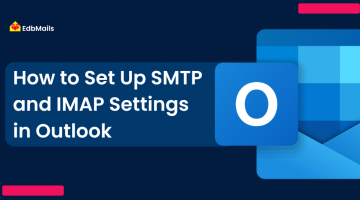When Microsoft released Exchange Server 2003, it quickly became one of the most widely adopted enterprise email platforms of its time. For more than a decade, organizations trusted it for email, calendaring, contacts, public folders, and collaboration.
However, Exchange 2003 is now an obsolete platform. Microsoft officially ended support on April 8, 2014, meaning there are no security updates, hotfixes, or technical assistance available. Organizations that continue to rely on Exchange 2003 face:
- Severe security vulnerabilities – Hackers actively target outdated servers.
- Compliance issues – Regulations like GDPR, HIPAA, SOX require secure and auditable communication systems.
- Risk of downtime and data loss – Legacy hardware and outdated software increase the likelihood of outages.
- Compatibility limitations – Modern Outlook clients, Windows Server editions, and Office 365 services no longer support Exchange 2003.
For these reasons, continuing to operate Exchange 2003 in 2025 and beyond is no longer practical. The only viable path forward is to migrate mailboxes and data to a supported version such as Exchange 2013, 2016, 2019, or Microsoft 365 (Office 365).
👉 The most efficient migration strategy is to leverage the offline Exchange 2003 EDB file and use purpose-built EDB to Exchange Migration Tool from EdbMails . This approach avoids the risks of direct coexistence, eliminates the complexity of double-hop migrations, and ensures a smooth, secure, and reliable transition.
Why Can’t You Directly Migrate from Exchange 2003 to Exchange 2013?
Many administrators initially look for a direct migration option from Exchange 2003 to Exchange 2013. Unfortunately, this is not possible with Microsoft’s native tools due to:
- Architectural differences – Exchange 2003 uses a completely different storage engine and Active Directory integration compared to Exchange 2013.
- No coexistence support – Exchange 2003 and 2013 cannot exist together in the same Active Directory forest.
- Double-hop requirement – The only Microsoft-supported path is 2003 → 2010 → 2013. This requires an intermediate Exchange 2010 server, additional licensing, and careful planning.
- Manual PST imports – While exporting mailboxes to PST and importing into 2013 is possible, it is time-consuming, prone to corruption, and not scalable for large organizations.
Instead of taking the double-hop or PST-only route, organizations can leverage offline Exchange EDB migration tools like EdbMails to directly move their Exchange 2003 data to newer platforms.
Option 1: Exchange 2003 EDB to Exchange 2013 / 2019 Migration (Recommended)
For organizations that want to remain on-premises, migrating directly from an Exchange 2003 EDB file to Exchange 2013, 2016, or 2019 is the most practical and future-proof option.
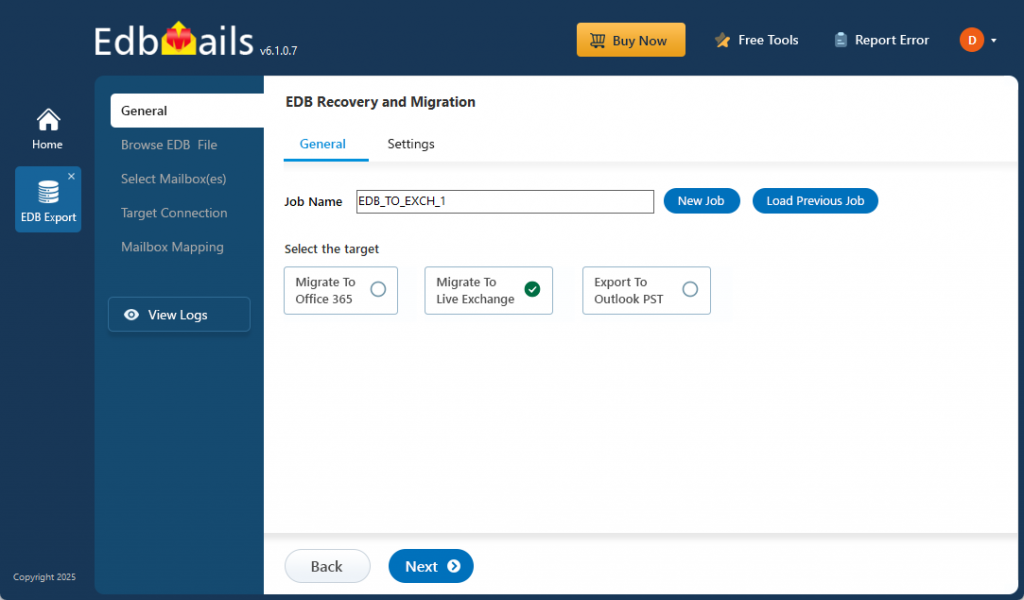
Using the EdbMails EDB to Exchange Migration Tool, you can avoid double-hop migrations and directly import mailboxes into the target Exchange environment.
Why Choose Exchange 2013 or Exchange 2019?
- Exchange 2013 was the immediate successor to Exchange 2003 and served as a natural upgrade path. However, it reached end-of-support in April 2023.
- Exchange 2019 is the most recent on-premises version, offering enhanced security, performance, and support for hybrid deployments with Office 365.
- If you must use Exchange 2013 (e.g., compatibility requirements), consider it an interim step, but the long-term plan should be to move to Exchange 2019 or Office 365.
Key Benefits of Using EdbMails EDB to Exchange Migration Tool
- Direct migration from Exchange 2003 EDB to Exchange 2013/2016/2019.
- No need for an intermediate Exchange 2010 server.
- Preserves mailbox hierarchy, permissions, shared mailboxes, public folders, calendars, contacts, and tasks.
- Incremental migration – If the process is interrupted, you can re-run it without creating duplicates.
- Zero downtime – Employees continue accessing email while migration runs in the background.
- Powerful filters (date, sender, subject, etc.) for selective migration.
- Detailed reports for compliance, auditing, and documentation.
👉 Step-by-step: Exchange EDB to Exchange Migration Guide
Option 2: Exchange 2003 EDB to Office 365 Migration (Future-Ready)
More organizations are choosing to move away from on-premises servers and adopt a cloud-first strategy with Microsoft 365 (Office 365).
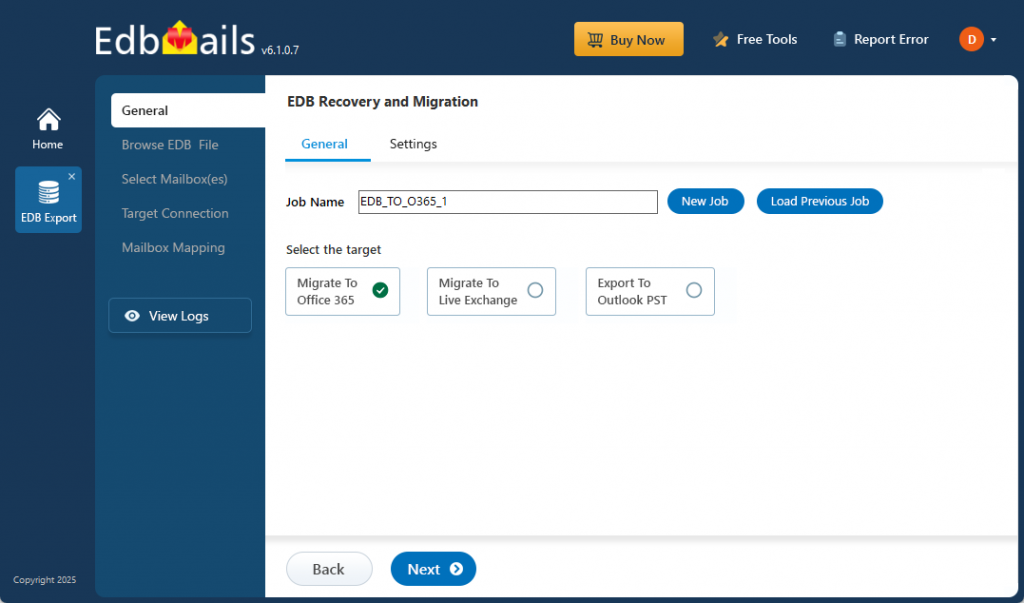
With EdbMails EDB to Office 365 Migration Tool, you can migrate Exchange 2003 mailboxes directly to Office 365 without relying on intermediate upgrades.
Why Move to Office 365?
- Always up-to-date with the latest features and security.
- Reduces IT overhead by eliminating hardware maintenance.
- Built-in compliance with industry standards like GDPR and HIPAA.
- Scales easily as your organization grows.
Benefits of EdbMails EDB to Office 365 Migration
- Direct migration from offline Exchange 2003 EDB → Office 365.
- Automatic mailbox mapping between source and target.
- Incremental sync ensures no duplicate emails.
- Supports modern authentication, MFA, and secure data transfer.
👉 Step-by-step: Exchange 2003 EDB to Office 365 Migration Guide
Option 3: Exchange 2003 EDB to PST Export (Backup / Staged Migration)
In many cases, administrators prefer to first export Exchange 2003 mailboxes to PST files. This serves as a backup option and also enables a staged migration strategy, where data can later be imported into a newer Exchange version or Office 365.
The EdbMails EDB to PST Converter is designed for this purpose. It can open offline Exchange 2003 databases (even if they are dismounted or corrupted) and export all mailboxes and items to PST format.
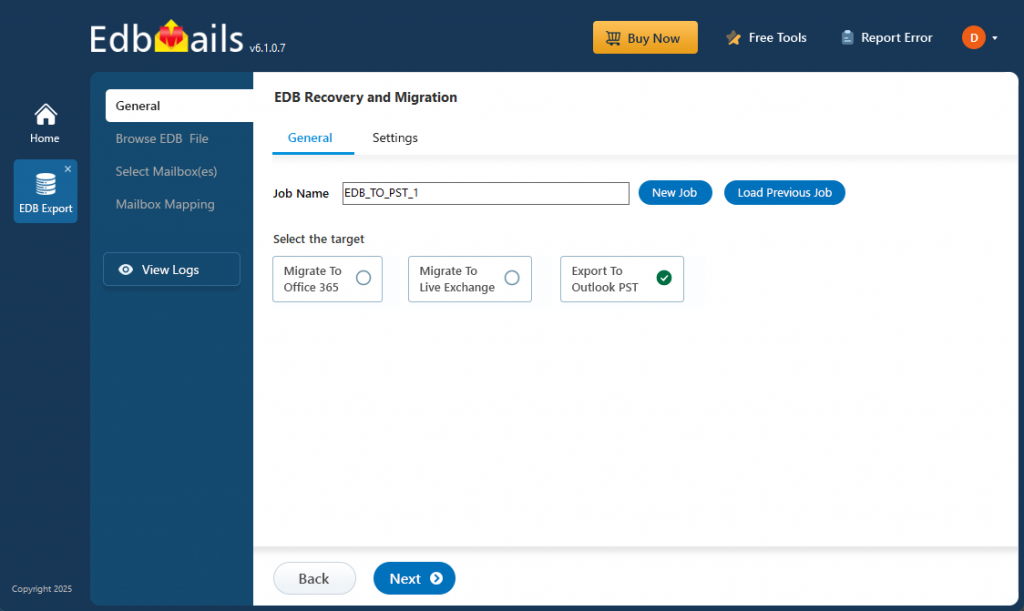
Key Benefits of EdbMails EDB to PST Converter
- Works with offline Exchange 2003 EDB files – no live server required.
- Recovers corrupted, damaged, or inaccessible databases.
- Restores permanently deleted items.
- Exports entire mailboxes (emails, contacts, calendars, tasks, journals, attachments).
- Ensures data integrity and folder structure preservation.
- Provides a trial version to export 30 items per folder.
Migrating PST Files Back to Exchange Server
Once you have PST files exported, the next step is often to import them into a target Exchange server (2013/2016/2019). For this, EdbMails offers two specialized solutions:
1. EdbMails Exchange Migration Tool (for bulk PST imports)
The EdbMails Exchange Migration Tool allows you to import multiple PST files in bulk directly into the target Exchange server. This is the best option if you have dozens or hundreds of mailboxes to migrate.
- Bulk import of PST files to multiple mailboxes at once.
- Direct migration to Exchange 2013, 2016, 2019.
- Preserves folder hierarchy, metadata, and permissions.
- Supports incremental migration to avoid duplicates.
👉 Guide: Restore multiple PST files to Exchange server
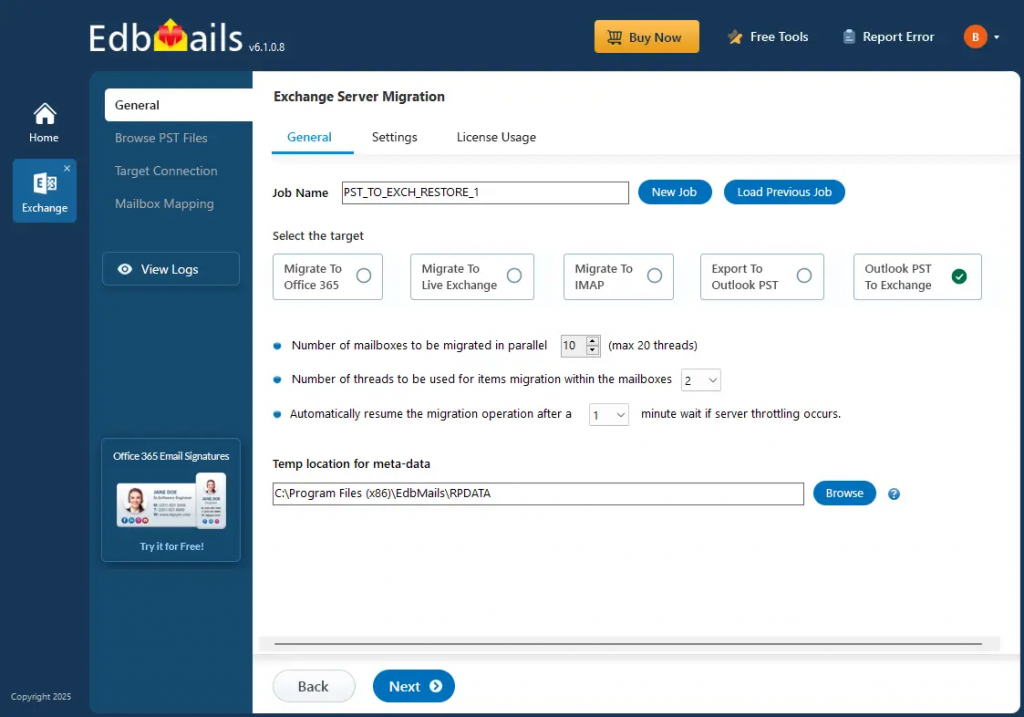
2. EdbMails PST Recovery and Migration Tool
The EdbMails PST Recovery and Migration Tool is ideal if you only need to migrate or recover PST files one at a time from a single computer.
- Supports migration of one PST file at a time on a single computer.
- Recovers corrupted, orphaned, or inaccessible PSTs.
- Migrates to Exchange (2013/2016/2019) or Office 365.
- Can be installed on multiple computers for parallel processing (requires Corporate or Technical edition license).
- Ensures incremental migration and prevents duplicates.
This tool is particularly useful when IT teams distribute workloads across multiple machines for faster completion.
👉 Guide: PST to Exchange Migration Guide

Conclusion:
Running Exchange 2003 in 2025 is no longer a sustainable option — it exposes organizations to security threats, compliance failures, downtime, and productivity loss. Traditional methods such as double-hop upgrades and manual PST imports are outdated, complex, and resource-heavy, making them impractical for modern IT environments. With EdbMails migration solutions, you can simplify and future-proof the entire process: migrate Exchange 2003 EDB files directly to Exchange 2013, 2016, or 2019, move seamlessly to Office 365 for a cloud-first strategy, export to PST for backup or staged upgrades, and even import bulk PST files into Exchange or Office 365 using the PST Recovery and Migration Tool. EdbMails ensures zero downtime, complete data integrity, and compliance readiness, enabling organizations to securely modernize their email infrastructure with confidence.

